Substance Abuse & Drug-free Workplaces
Cost of Substance Abuse Disorders
The National Safety Council reports addiction is an issue in every U.S. workforce. Approximately one out of every 11 U.S. workers — nearly 9 percent — had a substance abuse disorder in the last 12 months. Alcohol abuse disorders make up more than three-fourths of these cases (6.7%).
Other drugs that workers have difficulties with include cannabis (1.6%), prescription opioids (0.6%), cocaine (0.4%), tranquilizers (0.2%) and sedatives (0.2%).
The typical worker misses three work weeks (15 days) annually for illness, injury or reasons other than vacation and holidays. Workers with substance abuse disorders, however, miss two more weeks annually than their peers, averaging nearly five weeks (24.6 days) a year. [1]
Most of these extra days of missed work are associated with illness and injury.
Workers in recovery (who have reported receiving substance abuse treatment in the past and have not had a substance abuse disorder within the last 12 months) miss the fewest days of any group — even the general workforce — at 10.9 days. [1]
HECOgate focuses on a male employee victim, Scott Goold, who was 61 years of age when working for Hawaiian Electric Company (HECO). Scott did not have a substance abuse issue. He was legally prescribed medical cannabis for his chronic pain.
In over six months of employment at HECO, Scott was not sick one day. He didn't miss a single day of work. His coworker reported:
Hi Scott,
I personally never saw any evidence of you being impaired. Quite the contrary in fact. I would say sharp, expedient, professional, techical, humble, the whole package really.But I did notice you had a limp, so I suspected you were in pain, but you never mentioned anything, and I never bothered to ask. Our conversations were always about getting things done, and you delivered in times when we had to deliver and get things done.
Marijuana is a complex issue, often misunderstood, has been known to relieve pain, and when used correctly does not impair.
Sincerely,
[name withheld for confidentiality reasons]
Scott is politically active and partnered with current governor of Hawai'i, Dr. Josh Green, along with Dr. Suzanne (Sue) Sisley, to advocate for medical cannabis research, patients and reform.

Scott has long-established alleries to NSAIDs. Rather than use opioids, Scott selected cannabis as an alternative. His prescription called for medicating in the evening before bed to reduce pain so he could sleep soundly. Scott reported he never medicated prior to or during work hours.
Scott entered a unique program sponsored by the CDC and University of New Mexico School of Medicine beginning in 2009 to certify as a community addictions recovery specialist (CARS).

The mission of the program was to reduce opioid use, addiction and death. Scott is trained to administer Naloxone (brand name NARCAN) in case of overdose, and assist recovery with the use of buprenorphine (brand name SUBOXONE), and has expertise in drug interaction effects. Harm Reduction Saves Lives!
Former state representative Sharon Har would have been wise to consult with Scott Goold prior to combining a codeine cold medication with alcohol, which allegedly led Har to drive at high speed the wrong way down South Beretania Street.
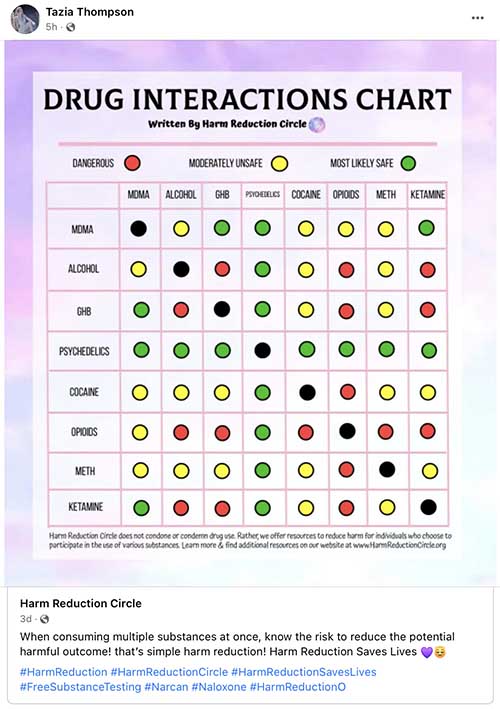
The National Safety Council conducted a survey focused on the impact of cannabis in the workplace; 500 employers and 1,000 employees completed the survey between April and May 2021.
Following a First Offense of cannabis use detection, organizationas are "most likely" to respond by explaining the company policy and returning the employee to their position. Only 5 percent of responding employers reported that they would dismiss a medical cannabis user. [enlarge illustration]
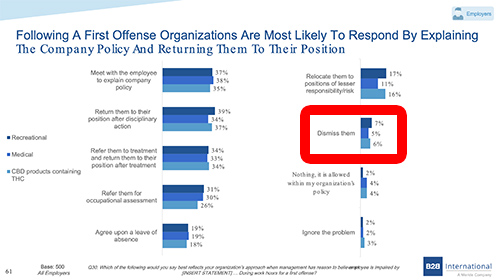
Under the corporate direction of CEO Connie Lau, not only was Scott Goold not made aware of a restriction on his medication, HECO fired him immediately, and initially extended no pathway to return to work. Hawaiian Electric's behavior is extremely cruel and unprofessional.
Factors of Substance Misuse in the Workplace
A whopping 66 percent of people admit that they have once used alcohol during work hours. Cannabis was the second most common substance to be used during work hours, with over 22 percent of respondents saying they have used the drug recreationally at work. [2]
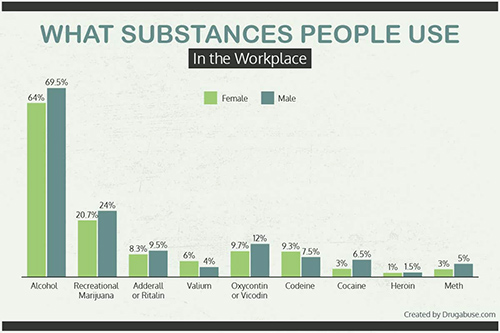
According to American Addiction Centers research, employees are most likely to stick to their prescribed amounts if they use medical cannabis. However, about 20 percent of people do use more than prescribed during work hours, and of those respondents, people who work from home full-time are most likely to use more than prescribed.
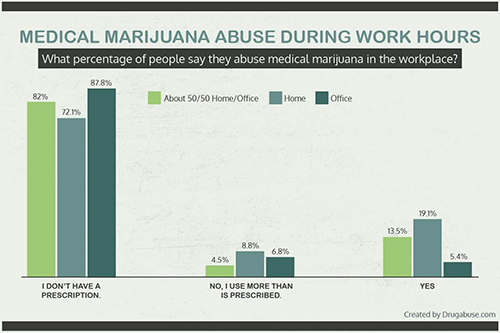
One sign of a substance misuse problem is the deterioration of workplace performance. The cognitive, emotional and behavioral impairment that results from drug or alcohol use can affect productivity, morale and even the safety of other co-workers. [3]
The cost of addiction in the workforce is usually measured financially, but it can also refer to more subjective losses, which can change the entire nature of an office.
A national survey of the U.S. workforce found that 15.3 percent of workers reported to working under the influence of alcohol, and 2.9 percent reported being under the influence of illicit drugs on the job. [3]
Another factor that can lead to alcohol use in the workplace includes a workplace culture that supports alcohol use as a normative behavior. While this affects a number of occupations, research indicates that the prevalence of risky drinking seems to take place in male-dominated industries, where the workforce is 70 percent or more male. [4]
Globally, alcohol-related problems with workers tend to be in the construction, utilities, manufacturing, agriculture, and transportation industries. Younger male workers have higher rates of substance abuse disorders overall. [5]
Sources
1. National Safety Council. (n.d.). Implications of Drug Use for Employers. https://www.nsc.org/work-safety/safety-topics/drugs-at-work/substances
2. American Addiction Centers Editorial Staff. (July 1, 2022). The Prevalence of Substance Abuse in the Workplace. American Addiction Centers. https://drugabuse.com/addiction/substance-abuse-workplace/
3. Generes, Wendy Manwarren. (Nov 9, 2022). The Effects of Substance Abuse in the Workplace. American Addiction Centers. https://americanaddictioncenters.org/rehab-guide/workforce
4. Frone, M. R., & Brown, A. L. (2010). Workplace substance-use norms as predictors of employee substance use and impairment: a survey of U.S. workers. Journal of studies on alcohol and drugs, 71(4), 526–534.
5. Roche, Ann & Lee, Nicole & Battams, Samantha & Fischer, Jane & Cameron, Jacqui & McEntee, Alice. (2015). Alcohol use among workers in male-dominated industries: A systematic review of risk factors. Safety Science. 78.
HEI and HECO Substance Abuse Policy
Constance Hee Lau authored the Hawaiian Electric Code of Conduct, dated November 17, 2017. She served as HEI president and CEO, as well as HECO Chairman of the Board. Under her leadership, the company pledged to pursue 'imi ono — to strive to be righteous.
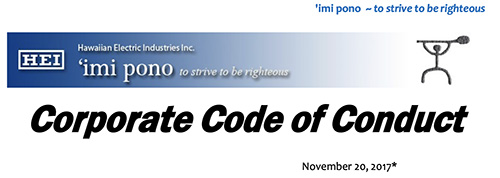

The Code applies to ALL Company directors, officers and employees (which for purposes of the Code includes all full-time, part-time, contract and temporary employees) are required to abide by the Code. Scott Goold was a contract employee of HECO.
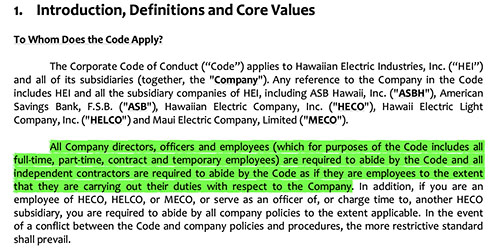
Appendix A applied to HECO specifically.

Confusion occurred in the workplace, due to Connie's outdated and imprecise direction. Words matter! CEO Lau prohibitted, "Reporting to work under the influence of alcohol or drugs," or "possession or the unprescribed use or distribution of any controlled substance or illegal drug."

Scott never reported to work under the influence of alcohol or drugs; and never was in possession or the unprescribed use or distribution of any controlled substance or illegal drug. At all times, Scott was a legal, prescribed medical patient in Hawai'i.
As research by the American Addiction Centers documented, employees like Scott are highly likely to stick to their prescribed treatment plan if they use medical cannabis.
One sign of a substance misuse problem is the deterioration of workplace performance. Scott's supervisor, Lori Yafuso, rated him as the GOAT contractor who set the bar "very high" for all future contrators.
YOU have been a great asset to our team and it is your personality and humble nature that makes all of us so comfortable working together. We have had contractors on the DBA team before, but never with the synergy and positive energy that you bring with you.
I believe you have had the greatest influence in our success and glad that we selected the right contractor. You have definitely made your mark here at HECO and have set the bar very high for future contractors!
Lori Yafuso, IT manager
Alcohol Consumption
A key factor that can lead to alcohol abuse in the workplace includes a workplace culture that supports alcohol use as a normative behavior.
Connie Lau specifically authorized alcohol consumption on company premises, "drinking alcoholic beverages as permitted at functions or events approved by your respective Company President."
It was common for managers, supervisors and coworkers to discuss plans to consume alcohol after work. Females tended to prefer wine after a long, challenging day; males spoke about having a few beers. Scott does not consume alcohol in any form.
Research consistently demonstrates, that globally, alcohol-related problems with workers tend to be in the construction, utilities, manufacturing, agriculture, and transportation industries. [5]
Research also indicates that the prevalence of risky drinking seems to take place in male-dominated industries, where the workforce is 70 percent or more male.
In an OCTOBER 12, 2016, Talk Story: Connie Lau, President & CEO, Hawaiian Electric Industries, reported:
We're over 40 percent women in our executive ranks at Hawaii Electric. That's impressive when you realize that more than 70 percent of our workforce is male. So, from that perspective, women are over-represented at Hawaiian Electric.
However, with all these high-risk substance abuse factors in play, in the more than six months Scott worked for Hawaiian Electric, he never received any memo or educational materials warning of the dangers and concerns of substance abuse. Connie Lau's empire displayed no urgency or concern about substance abuse.
Age and Gender Factors
Another key factor is younger male workers have the higher rates of substance abuse disorders overall. Scott was 61 years of age. He uses no recreational drugs.
Scott was raised in a Mormon community. Doesn't drink alcohol, never smoked a cigarette or vaped nicotine. He simply uses medical cannabis rather than prescribed opioid pain analgesics.
Negligence and Discrimination
Two years after being terminated by Hawaiian Electric, Scott first learned HECO had a substance abuse policy.

Corporate rules required that the policy be made available to all employees. HECO staff failed. As stated above, nobody was concerned about substance abuse at the company.

The Company deceptively claims they have a "strong commitment to the health, safety and well-being of all employees." They don't, although acknowledging substance abuse, while at work or otherwise, seriously endangers the safety of employees as well as the general public, and creates a variety of workplace problems including increased injuries on the job, increased absenteeism, increased health care and benefit costs, possible fatalities and/or property damage.

Hawaiian Electric from CEO Connie Lau down to Corporate Compliance to Human Resources had absolutely zero commitment to the health, safety and well-being of all employees.

The over-represented Asian females who managed HECO, negligently disregarded their duties to protect the over 70 percent male workforce. All agency temporary workers, contractors, consultants, and vendors, employees like Scott, who performed services for the Company were required to also abide by the Substance Abuse Policy.
They didn't make the policy available to Scott. Likely not to 1,000s of contractors, temporary workers, consultants and vendors.
The company's substance abuse intervention occurred at the pre-employment hiring phase; a protocol that discriminated against a long-term medical patient like Scott.
A recreational user of cannabis, aware of HECO substance abuse policy, could abstain for 3-5 days, pass the drug screen, start work and return to using recreational cannabis, opioids, meth, cocaine or whatever flavor of illicit substance they preferred.
Scott was a legal medical patient, a proficient, hard-working and ethical employee who suffered discrimination and a hostile work environemnt, due to poorly-trained and unprofessional management.
It takes a medical patient like Scott sometimes months to rid fat deposits in the body of THC-COOH, which is a non-intoxicating by-product of Delta THC — the intoxicating compound. Scott might change medications, end use of cannabis, but weeks or months later indicate positive on a urine screen.
Scott requested a blood or breathalyzer test, as these tests measure Delta THC, intoxication or impairment. HECO refused.
Corportate policy required Scott to report his legal medication to his supervisor prior to beginning work so fitness for duty could be determined. Management failed to enforce their abuse policy — recklessly endangering employees, the company and general public.

Hawaiian Electric Gave Women a Chance to Lead
In CEO Lau's OCTOBER 12, 2016, Talk Story, she remarked:
"It has to happen because the company's leaders, both in the executive ranks and at the board level, are willing to give women a chance, willing to create a level playing field. To me, that’s pretty straightforward, and frankly that's all we ask for: a level playing field. If you have that level playing field, then those women who have the talent and desire to get to the top can do so."
Company leaders took a chance on women; they leveled the playing field to allow women who desired to get to the top could do so. In return, the privileged women neglected their responsibiities, their kuleana, to protect ALL employees, and unleveled the playing field for an outstanding employee, Scott Goold.
All Scott Goold asked was for a level playing field. Instead, the Asian women failed to make available the substance abuse policy, failed to inform him when he specifically inquired about the company policy, misled him about being officially selected, and terminated Scott in an embarrassing, humiliating, cruel and demeaning manner.
The female executives and managers placed HECO staff and employees at risk, the company overall, as well as the general public. They should have been the ones to lose their jobs; instead they fired a GOAT IT employee.
Similar to the Edo period in Japan, the privileged Asian women at Hawaiian Electric used Scott Goold to take blame for a lot more than their farts.
